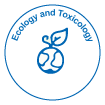Pesticide Runoff and Its Effects on Freshwater Biodiversity: A Toxicological Evaluation
Received: 30-Dec-2024 / Manuscript No. jety-25-161242 / Editor assigned: 02-Jan-2025 / PreQC No. jety-25-161242 / Reviewed: 18-Jan-2025 / QC No. jety-25-161242(QC) / Revised: 22-Jan-2025 / Manuscript No. jety-25-161242(R) / Published Date: 30-Jan-2025 DOI: 10.4172/jety.1000263
Abstract
Pesticide runoff from agricultural and urban areas has become a critical environmental issue, leading to the contamination of freshwater ecosystems. The presence of pesticides in aquatic environments poses significant threats to freshwater biodiversity by altering species composition, disrupting food webs, and causing physiological stress in aquatic organisms. This study evaluates the toxicological impacts of pesticide runoff, examining its effects on various freshwater species, bioaccumulation processes, and ecosystem health. Findings indicate an urgent need for sustainable agricultural practices and regulatory measures to mitigate pesticide pollution and protect freshwater biodiversity
Introduction
Pesticides are widely used to enhance agricultural productivity and control pests in urban settings. However, their unintended discharge into freshwater ecosystems via surface runoff, leaching, and atmospheric deposition leads to severe ecological consequences. Many pesticides persist in aquatic environments, affecting non-target organisms and leading to biodiversity loss. This article aims to assess the toxicological effects of pesticide runoff on freshwater biodiversity, highlighting key ecological disruptions and potential mitigation strategies [1].
Discussion
Pesticide runoff primarily originates from agricultural fields, residential areas, and industrial sites. Rainfall, irrigation, and improper disposal facilitate the movement of these chemicals into freshwater bodies, where they can persist for extended periods. Factors such as soil composition, pesticide solubility, and landscape topography influence the extent of contamination [2]. The entry of pesticides into freshwater ecosystems leads to toxic effects on aquatic organisms, including fish, amphibians, invertebrates, and microorganisms. Pesticides can interfere with reproductive systems, disrupt endocrine functions, and impair metabolic activities. Additionally, the decline of keystone species can result in cascading effects throughout the food web, altering ecosystem stability and function. Certain pesticides exhibit high persistence and bioaccumulative potential, leading to their accumulation in aquatic organisms. Bioaccumulation occurs when organisms absorb pesticides at a rate faster than they can excrete them, while biomagnification refers to the increasing concentration of these chemicals as they move up the food chain. This process poses serious risks to higher trophic-level species, including predatory fish and birds, and can ultimately affect human health. The toxic effects of pesticides vary based on their chemical composition, concentration, and exposure duration. Some pesticides induce acute toxicity, causing immediate mortality, while others lead to chronic toxicity, resulting in long-term physiological and behavioral changes. Common toxic effects include neurological disorders, developmental deformities, immune suppression, and increased susceptibility to diseases. Reducing pesticide runoff requires integrated management approaches, including the adoption of sustainable agricultural practices, such as buffer zones, no-till farming, and precision pesticide application. Policy interventions, such as stricter regulations on pesticide use, enhanced monitoring programs, and public awareness initiatives, are essential for minimizing environmental contamination. Additionally, the development of eco-friendly pesticides and bio pesticides offers a promising alternative to traditional chemical-based solutions [3-5].
Conclusion
Pesticide runoff poses a significant threat to freshwater biodiversity, leading to ecological imbalances and toxicological risks for aquatic organisms. Understanding the sources, pathways, and impacts of pesticide contamination is crucial for developing effective mitigation strategies. Collaborative efforts between policymakers, researchers, and stakeholders are necessary to promote sustainable practices and ensure the protection of freshwater ecosystems for future generations.
Acknowledgment
None
Conflict of Interest
None
References
- Carthew RW, Sontheimer EJ (2009) Origins and mechanisms of miRNAs and siRNAs. Cell 136: 642–655.
- Li C, Zamore PD (2019) RNA interference and small RNA analysis. Cold Spring Harbor Protoc 4: 247–262.
- Liu S, Jaouannet M, Dempsey DMA, Imani J, Coustau C, et al. (2020) RNA-based technologies for insect control in plant production. Biotechnol Adv 39: 107463.
- Clancy S (2008) The central dogma of molecular biology suggests that the primary role of RNA is to convert the information stored in DNA into proteins. In reality, there is much more to the RNA story. Nature Education 1: 102.
- Borges F, Martienssen RA (2015) The expanding world of small RNAs in plants. Nature Rev Mol Cell Biol 16: 727–741.
Indexed at, Google Scholar, Crossref
Indexed at, Google Scholar, Crossref
Indexed at, Google Scholar, Crossref
Citation: Shenming W (2025) Pesticide Runoff and Its Effects on Freshwater Biodiversity: A Toxicological Evaluation. J Ecol Toxicol, 9: 263. DOI: 10.4172/jety.1000263
Copyright: © 2025 Shenming W. This is an open-access article distributed under the terms of the Creative Commons Attribution License, which permits unrestricted use, distribution, and reproduction in any medium, provided the original author and source are credited.
Share This Article
Recommended Journals
Open Access Journals
Article Tools
Article Usage
- Total views: 121
- [From(publication date): 0-0 - Apr 28, 2025]
- Breakdown by view type
- HTML page views: 79
- PDF downloads: 42
